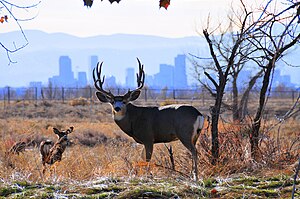Rocky Mountain Arsenal National Wildlife Refuge
| Rocky Mountain Arsenal National Wildlife Refuge | |
|---|---|
|
IUCN category IV (habitat/species management area)
|
|

Mule deer in Rocky Mountain Arsenal National Wildlife Refuge; downtown Denver is visible in the background.
|
|
| Location | Adams County, Colorado, U.S. |
| Nearest city | Commerce City, Colorado |
| Coordinates | 39°50′0″N 104°50′30″W / 39.83333°N 104.84167°WCoordinates: 39°50′0″N 104°50′30″W / 39.83333°N 104.84167°W |
| Area | 15,988 acres (64.70 km2) |
| Established | 1992 |
| Visitors | 300,000 (in 2013) |
| Governing body | United States Fish and Wildlife Service |
| Website | Rocky Mountain Arsenal National Wildlife Refuge |
The Rocky Mountain Arsenal National Wildlife Refuge is a 15,988-acre (64.70 km2) National Wildlife Refuge located adjacent to Commerce City, Colorado, in the United States. It is approximately 8 miles (13 km) northeast of downtown Denver. The facility is on the grounds of the former Rocky Mountain Arsenal, a United States Army chemical weapons manufacturing facility. The site was designated a national wildlife refuge in 1992 by the United States Congress, and underwent a costly environmental cleanup in order to remove pollutants. The refuge is managed by the United States Fish and Wildlife Service. More than 330 species of wildlife inhabit the refuge, including raptors, deer, raccoons, coyotes, white pelicans, black-footed ferrets, black-tailed prairie dogs, and bison.
The Rocky Mountain Arsenal (RMA) was built in 1942 to manufacture chemical weapons. A portion of the site was leased to private industry in 1946 for petroleum production and agricultural and industrial chemical manufacturing. When the American chemical weapons program was shut down after the Vietnam War, the RMA served as a site for dismantling and disposing of these weapons. The Shell Oil Company also used a portion of the site in the 1980s to produce pesticides. The RMA was closed in 1985, and in 1987 environmental testing revealed that the site was extremely polluted. The RMA was listed on the National Priorities List, a list of hazardous waste sites in the United States eligible for long-term remedial action (cleanup) financed under the federal Superfund program run by the Environmental Protection Agency.
...
Wikipedia

